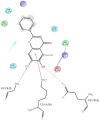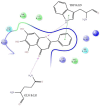Modeling and Molecular Dynamics Studies of Flavone-DENV E-3 Protein-SWCNT Interaction at the Flavonoid Binding Sites
- PMID: 40284968
- PMCID: PMC12031533
- DOI: 10.3390/v17040525
Modeling and Molecular Dynamics Studies of Flavone-DENV E-3 Protein-SWCNT Interaction at the Flavonoid Binding Sites
Abstract
The DENV virus circulates freely in endemic regions and causes dengue disease. The vectors are Aedes aegypti and Aedes albopictus. The difficulties inherent in the nature of the DENV virus, its epidemiology, and its increasing incidence in recent years have led to the development of viable alternatives in the search for effective solutions for the treatment of this severe disease. Flavones such as tropoflavin, baicalein, and luteolin have anti-DENV activity. Molecular docking studies were performed between the flavones tropoflavin, baicalein, and luteolin and the DENV E-3 protein. Flavone-DENV E-3 complex interactions were analyzed at the flavonoid binding sites domain I of the B chain and domain II of the A chain reported in the literature. H-bond, π-π stacking, and π-cation interactions between flavones and the DENV E-3 protein at different binding energies were evaluated. Molecular dynamics studies for these interactions were performed to determine the molecular stability of the Flavone-DENV E-3 complexes. I also present here the results of the molecular interactions of the Flavone-DENV E-3-SWCNT complex. Due to recent advances in nanotechnology and their physicochemical properties, the utilization of nanoparticles such as SWCNT has increased in antiviral drug delivery.
Keywords: DENV E-3 protein; Flavone—DENV E-3 interactions; SWCNT–flavonoids; anti-DENV drugs; antiviral pharmacology; docking molecular; flavones; molecular dynamic simulation; nanomedicine; non-covalent interaction.
Conflict of interest statement
The author declares no conflicts of interest.
Figures
















 H-bonds,
H-bonds,  hydrophobic,
hydrophobic,  Ionic,
Ionic,  Water bridge.
Water bridge.
 H-bonds,
H-bonds,  hydrophobic,
hydrophobic,  Ionic,
Ionic,  Water bridge.
Water bridge.
 H-bonds,
H-bonds,  hydrophobic,
hydrophobic,  Ionic,
Ionic,  Water bridge.
Water bridge.

 H-bonds,
H-bonds,  hydrophobic,
hydrophobic,  Ionic,
Ionic,  Water bridge.
Water bridge.Similar articles
-
Inhibition of dengue viruses by N-methylcytisine thio derivatives through targeting viral envelope protein and NS2B-NS3 protease.Bioorg Med Chem Lett. 2024 Feb 1;99:129623. doi: 10.1016/j.bmcl.2024.129623. Epub 2024 Jan 18. Bioorg Med Chem Lett. 2024. PMID: 38242331
-
Computational insights into flavonoids inhibition of dengue virus envelope protein: ADMET profiling, molecular docking, dynamics, PCA, and end-state free energy calculations.PLoS One. 2025 Jul 9;20(7):e0327862. doi: 10.1371/journal.pone.0327862. eCollection 2025. PLoS One. 2025. PMID: 40632786 Free PMC article.
-
Domperidone inhibits dengue virus infection by targeting the viral envelope protein and nonstructural protein 1.Sci Rep. 2025 Jan 30;15(1):3817. doi: 10.1038/s41598-025-87146-w. Sci Rep. 2025. PMID: 39885306 Free PMC article.
-
Pharmacophoric characteristics of dengue virus NS2B/NS3pro inhibitors: a systematic review of the most promising compounds.Arch Virol. 2018 Mar;163(3):575-586. doi: 10.1007/s00705-017-3641-5. Epub 2017 Nov 16. Arch Virol. 2018. PMID: 29147793
-
Wolbachia-carrying Aedes mosquitoes for preventing dengue infection.Cochrane Database Syst Rev. 2024 Apr 10;4(4):CD015636. doi: 10.1002/14651858.CD015636.pub2. Cochrane Database Syst Rev. 2024. PMID: 38597256 Free PMC article.
Cited by
-
Novel Antiviral Agents: Synthesis, Molecular Modelling Studies and Biological Investigation, 2nd Edition.Viruses. 2025 Apr 23;17(5):601. doi: 10.3390/v17050601. Viruses. 2025. PMID: 40431614 Free PMC article.
References
-
- Araújo J.M.G., Nogueira R.M.R., Schatzmayr H.G., Zanotto P.M., Gonzalo Bello G. Phylogeography and evolutionary history of dengue virus type. Infect. Genet. Evol. 2009;9:716–725. - PubMed
-
- World Health Organization Disease Outbreak News; Dengue—Global Situation. [(accessed on 21 December 2023)]. Available online: https://www.who.int/emergencies/disease-outbreak-news/item/2023-DON498.
MeSH terms
Substances
LinkOut - more resources
Full Text Sources
Research Materials
Miscellaneous

